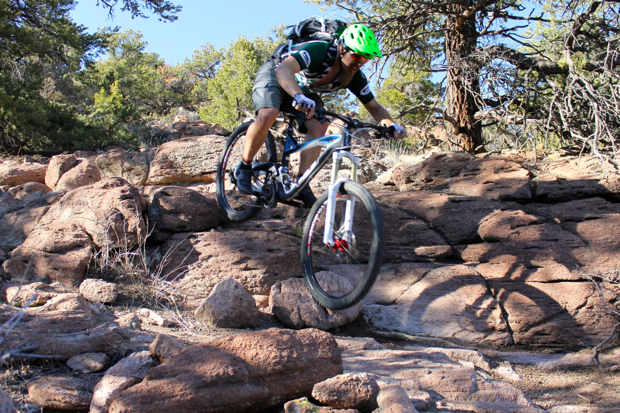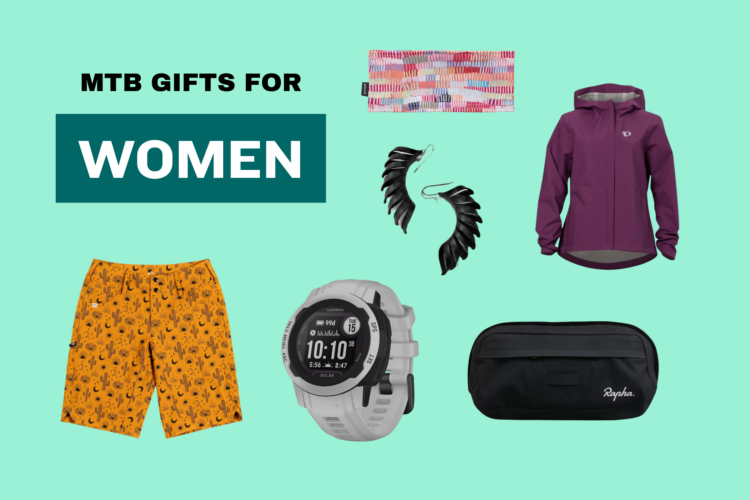In a world being overtaken by longer travel, wider bars, and of course, 650b wheels, one company has dedicated themselves to building simple, lightweight, carbon fiber hardtail racing bikes.
It’s okay if you read that in the Movie Trailer Guy’s voice…
For the past few months I’ve been tearing it up on the brand-new Foundry Tomahawk, which is their 650b carbon hardtail. For complete specs, check out the On review article. I’ll wait.
Okay, you’re back. Here are my impressions after putting some dirt under this bike.
Test Environment
During my time with the Tomahawk, I have made my way around the Colorado Front Range, as well as a quick excursion to Moab. While the Tomahawk’s carbon frame and fairly steep angles are clearly slanted in favor of XC racing, rather than relegate it to buff, fast singletrack, I made a point of taking it on some classic Colorado Front Range trails, including the infamous Deer Creek Canyon trail. Full disclosure: I did not ride it down the Wall of Shame, but it handled everything else there just fine. The lightweight carbon frame is also a breeze to carry on the stairs. 😀
Ride Impressions
The Tomahawk is fast. Really fast. According to my Strava data, it’s faster than any other bike I have ever ridden. On each trail I have taken it on that had previous ride data, this bike smashed nearly every Personal Record. Climbing, descending, flats… no segment is safe from this bike.
More than just a straight-line rocket, though, the 650b wheels on the Tomahawk manage all that speed with finesse and control. Due in part to the 15mm front axle and 12×142 rear, tight, twisty singletrack feels like a slalom course, and big sweeping turns can be carved hard with a gain in speed on the exit. Even coming in a little hot isn’t a showstopper, and the bike will drift predictably when pushed. While 29ers can still haul the mail on long straightaways, 650b bikes more than make up the difference when things get tight. Going with Foundry’s hand tool naming convention, they could have accurately named this bike the Slingshot.
Climbing
With an equipped weight of just over 24 lbs, the Tomahawk is lighter than mtbgreg1’s hydration pack. On smooth uphills, the 2×10 drivetrain drives the bike ahead effortlessly. Coming from a full suspension 29er, chunky uphill trail sections initially caused me some grief, but it didn’t take long to re-acquaint myself with correct technique and properly deal with uphill chunder. The Tomahawk wheelies easily, and lofting the front end over obstacles is effortless. Conversely, the front end will try to come up on really steep uphills, but sliding forward a little on the saddle keeps both wheels on the ground.
Descending
With a 71° head angle and an overall XC setup, on paper the Tomahawk doesn’t seem like it would be a confident descender. But surprisingly, it is. With the 650b wheels providing decent rollover capability, the carbon frame helping soak up some trail chatter, and the stiff, precise steering of the 15mm Reba fork and tapered headset, picking a line down steep, bumpy downhills is a breeze. Unlike on a 29er, you do need to pick a line, however when push comes to shove that little extra wheel diameter will save your butt.
650b versus 29er
So does this bike steal any thunder from its big brother, the Broadaxe? With similar geometry and component specs, and of course sharing identical carbon frame construction, this choice will come down to personal preference. That being said, however, for shorter riders the more compact sizing of the Tomahawk is a no-brainer. Foundry seems to agree, since they offer the Tomahawk in x-small, small and medium only. Sorry tall guys, you’ll still need to ride the 29er.
Gripes
As much fun as I had on this bike, there are still some misses in my opinion. While the carbon frame is definitely the star of the show, some of the component choices left me scratching my head. The XT Shadow Plus rear derailleur worked flawlessly, but then Foundry went with a Deore front derailleur and SLX shifters. This doesn’t make sense since QBP, Foundry’s parent company, sells build kits of SLX, XT and XTR, with complete brake sets and drivetrain in one box. Breaking up the component build just seems weird, and none of the component deviations results in lighter weight or better performance… they’re just cheaper.
While the drivetrain components did work as advertised, the Deore brakes with 160mm rotors were a disappointment. On long, steep, fast downhills, stopping power was definitely lacking. The bike itself is so capable, it’s a shame that its potential is limited by such a bizarre component choice. Upgrading the front rotor to a 180mm definitely helps, or you can step up to the B2 model to get SLX brakes.
My final complaint is the Stan’s Rapid wheels. The Rapid model is an OEM-only offering. According to Stan’s, “the Rapid is most similar to the Crest aftermarket rim, though wider.” What the Rapid is not is stiff. To be fair, I exceed the weight limit of the similar Crest, however, there is no weight limit listed for this wheel. At any rate, on a four inch ledge drop at speed the rear wheel stuffed itself into the seat stay on the slightly off camber landing. This happened at Outerbike, so I made a point of taking a number of bikes over this same section of trail, and even revisited it with the Tomahawk sporting some demo Enve wheels–only the Stan’s wheels had an issue.
Bottom line: this is a hardtail bike retailing north of $3,000, so come on guys, you can step up the parts a little. (To be fair, the X01 equipped B2 model addresses all but the wheels, but also bumps the price to over $4,000.)
Parting Thoughts
Despite my gripes, let me reiterate that the Tomahawk is a thrill to ride, and what it lacks in component choices it makes up for in performance and handling. For serious racers under 5’7″ or so, this will be a formidable race day tool that can also handle day-to-day trail and training rides. The light weight takes a lot less energy to pedal and the carbon frame is comfortable and forgiving. Even on longer rides, I didn’t really find myself missing the full suspension… much.
Since the stock component group may lead to an instant case of upgrade-itis, Foundry also sells this as a bare frame for $2,050, allowing even the fussiest rider to achieve the perfect build.
Given the pricepoint of this bike series, it’s certainly not for everyone. But if you’re in the market for a well-mannered carbon fiber race whip, this is a solid choice, whether as a bare frame, the 2×10 B3 build I tested, or the X01 B2 build.
Thanks to Foundry Cycles for setting up the long term demo of the Tomahawk!
















3 Comments
Dec 30, 2013
This sounds like an AWESOME bike, and I wished I lived somewhere (like NC) where there is a lot of steep tight twisty singletrack to rail it. Great review...makes me want to buy one!
Dec 29, 2013
Dec 29, 2013